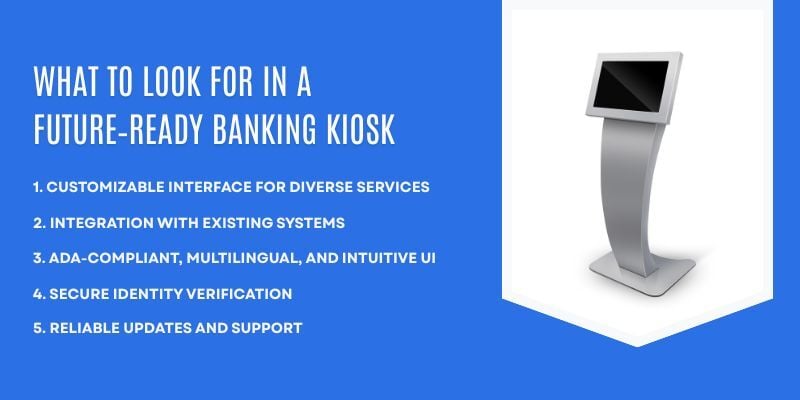On a weekday morning, a man walks into his neighbourhood bank branch. Instead of waiting in line to speak with a teller, he heads straight to a touchscreen kiosk.
Within minutes, he prints a mini-statement, updates his contact details, and even initiates the process for a new debit card. No paperwork. No back-and-forth.
Self-service kiosks are becoming a practical solution as banks seek ways to manage high foot traffic, reduce operational strain, and meet rising customer expectations with fewer staff members.
Long lines frustrate visitors. Staff shortages slow down service. Legacy systems make basic tasks inefficient.
According to McKinsey, banks now spend nearly 10% of their revenue on technology to enhance efficiency while maintaining customer satisfaction.
The future of self-service banking kiosks lies in helping branches complete routine transactions faster, more accurately, and without relying on teller availability.
Why Self-Service Banking is Gaining Momentum
Bank branches are no longer the first stop for everyday transactions. Customers want faster service, digital convenience, and fewer in-person steps, whether they’re checking a balance, updating personal information, or printing a statement.
This behaviour change is exposing operational pressure points. With fewer tellers and limited floor space, many branches struggle to manage peak-hour traffic or handle basic service requests without delays.
Long queues reduce satisfaction, and overburdened staff cannot consistently deliver the level of service customers expect.
To ease these challenges, many banks are integrating self-service kiosks into branch workflows. By allowing customers to complete routine transactions through an on-screen interface, kiosks help reduce crowding at counters and free up staff for more complex needs. This results in faster turnaround times and smoother in-branch operations.
During the pandemic, self-service systems were introduced to minimise contact and manage limited staffing resources.
Today, they continue to support a smoother customer experience in banking by helping branches operate more efficiently while still meeting expectations for speed and ease.
What Modern Banking Kiosks Can Do
Self-service kiosks in banking are no longer limited to dispensing cash. In many branches, they now handle a wide range of services that reduce pressure on staff and improve the customer flow.
Here’s what modern kiosks make possible inside the branch:
- Bill Payments: Customers can settle utility bills, credit card dues, and government fees without waiting in line.
- Loan Pre-Screening: On-screen forms help customers complete eligibility checks for personal, business, or auto loans before meeting with a loan officer.
- Instant Card Replacement: Lost or damaged debit cards can be replaced on the spot, thanks to secure ID verification and instant card printing.
- Check Deposits: Kiosks equipped with scanning and validation systems enable users to deposit checks quickly, significantly reducing wait times.
- Account Opening: From identity scans to KYC data entry, kiosks guide users through the process, cutting down one of the longest in-branch procedures.
- Document Services: Customers can scan and print statements, account summaries, and official paperwork directly from the machine.
All of this is made possible by a direct connection to core banking systems, allowing for real-time updates across accounts and ensuring consistency across all touchpoints.
Solutions like Wavetec’s self-service kiosks take this a step further by working seamlessly with existing infrastructure, enabling banks to expand services without overhauling their back-end systems.
Authentication features like biometrics and OTPs provide added security and help maintain compliance.
By supporting everything from everyday banking tasks to more complex services, these machines improve the in-branch experience. For customers, it’s a more direct, self-led way to bank. For staff, it’s fewer routine tasks and more time for high-value conversations.
When used alongside cash deposit machines (CDMs), kiosks help reduce pressure on counters and improve overall branch throughput.
And when connected with enterprise cash management solutions, they offer visibility into transaction patterns, help detect unusual activity, and optimise cash float, giving banks more control over daily operations.
Benefits of Self-Service Banking Kiosks

Kiosks ease teller workloads, speed up transactions, and shorten queues. Tasks like bill payments, statement printing, and cheque deposits can be completed without waiting at a counter.
For banks, this means better resource allocation, shorter wait times, and improved customer satisfaction.
Kiosks also support 24/7 access in secure lobbies or ATM areas, ensuring that essential services are available even when the branch is closed. This improves convenience without increasing operational costs.
By automating common transactions, banks can redirect staff to advisory roles, resulting in more meaningful branch interactions, particularly in high-traffic or urban locations.
1. Reduced Wait Times and Branch Congestion
When customers can handle things like balance inquiries, cheque deposits, or statement printing themselves, branch staff are freed up to assist those who need more time or support.
This helps manage foot traffic during peak hours and shortens queues, especially in busy locations. Faster service also improves customers’ perceptions of the bank, even if they’re only there to make a quick deposit.
2. Lower Staff Workload and Better Allocation
Most teller lines are clogged with low-value transactions that don’t require human help. Kiosks absorb those interactions, such as passbook updates or utility bill payments, so staff can be reallocated to tasks that require more time and attention.
In high-traffic branches, this change makes a real difference. Fewer bottlenecks. Fewer frustrated customers. And teams that can focus on onboarding, upselling, or financial guidance instead of stamp duty and data entry.
3. Improved Customer Satisfaction with Quicker Service
Speed matters. Customers walking in for a quick payment or to print a statement don’t want to wait 15 minutes. Kiosks provide consistent, self-directed service, making these tasks faster and more convenient.
According to McKinsey, banks that expand self-service options experience 10-20% higher customer satisfaction, especially in branches where time is a critical factor.
One bank that experienced this transformation is Diamond Trust Bank Kenya. To improve its cheque processing, the bank partnered with Wavetec to introduce modern cheque deposit kiosks integrated with back-end software, enabling real-time processing.
The result was a noticeable reduction in wait times and manual workload. Customers could deposit cheques instantly without needing staff assistance, while the bank gained better compliance and security through integrated fraud detection and KYC checks.
This approach improved customer experience while helping the bank better use its in-branch resources.
4. Reduced Operational Overhead
Manual transactions are not just slow but also costly. Between staffing, training, and error resolution, traditional processes carry a high overhead. Self-service kiosks streamline these operations.
By automating tasks like cheque deposits, balance inquiries, or passbook printing, banks can deliver more services without increasing costs. Over time, this reduces operational costs while improving scalability and overall service quality.
5. Greater Accessibility for Underserved Areas
Self-service kiosks make it possible to offer core banking services, like cash withdrawals, card replacement, and account updates, in areas where setting up a full branch isn’t practical.
Instead of relying solely on traditional infrastructure, banks can use these kiosks to maintain a cost-effective physical presence. This helps them reach more communities, serve customers closer to home, and meet basic banking needs without heavy staffing or real estate investment.
By removing barriers to access, kiosks bring everyday banking within reach for more people, especially in remote or low-traffic areas where every interaction counts.
Kiosks and the Changing Role of Bank Branches
Today’s branches aren’t just places to deposit checks or withdraw cash. They’re becoming spaces where customers go for guidance on mortgages, investment decisions, and other complex needs.
As routine transactions move to digital channels, the branch’s purpose becomes more focused on in-person advice and problem-solving.
Self-service kiosks support this direction. By offering reliable financial self-service touchpoints, banks can handle common tasks, like cheque deposits or statement printing, without involving staff. This frees up frontline teams to focus on customer engagement where it matters most.
As Andrés Cueto, former Director of ATM Channel & Branch Strategy at BBVA Compass, put it: “We’re trying to merge digital experience with customer need.”
This philosophy demonstrates how self-service technologies, such as kiosks, help combine physical convenience with digital functionality within the branch.
Integrated with existing digital banking solutions, kiosks also ensure consistency across physical and online experiences. Customers can initiate a transaction at a kiosk and continue it later through a mobile app, or vice versa, without needing to restart the process.
A report by Accenture found that 71% of banking customers in the US still prefer visiting branches for advice and major decisions, especially when trust and financial risk are involved.
Kiosk deployment also makes it easier to manage peak hours. Instead of adding more counters or staff, banks can install additional kiosks to reduce wait times and improve flow, while maintaining a staffed presence for higher-priority support.
What to Look for in a Future‑Ready Banking Kiosk

Choosing the right kiosk requires attention to both user experience and operational integration. Below are the primary capabilities institutions should look for when planning kiosk investments:
1. Customizable Interface for Diverse Services
Look for kiosks with user interfaces that can be customized for various banking tasks, such as cash and cheque deposits, bill payments, card issuance, account opening, and more.
A flexible design lets banks support a range of financial self-service options while meeting local language and usability needs.
2. Integration with Existing Systems
Ensure the kiosk integrates with POS terminals, CRM platforms, and core banking systems. A seamless connection means staff don’t have to switch platforms, and data remains consistent across all channels.
Good integration also supports customer experience by allowing transactions started at a kiosk to be picked up later via mobile or web channels without friction.
3. ADA-Compliant, Multilingual, and Intuitive UI
Kiosk solutions must be accessible to all users. Look for ADA compliance, touchscreen accessibility options, and support for multiple languages.
A straightforward, simple interface reduces errors and helps customers adapt quickly. This is crucial for bank branch transformation that emphasizes inclusivity and ease of use.
4. Secure Identity Verification (KYC, Biometric, PIN, OTP)
Kiosks should support KYC authentication through biometric scanning, OTP, PIN, or card-based methods. These options ensure regulatory compliance and facilitate secure transactions, enabling secure banking solutions that customers can trust.
At Bank Alfalah, a major private bank in Pakistan with over 700 branches, Wavetec’s CQuick cash deposit kiosks have been deployed in more than 200 locations.
The deployment addressed heavy reliance on manual cash processes, limited operating hours, and customer adaptation challenges. These kiosks integrate KYC verification, support bulk cash deposits, and offer a multilingual, biometric-enabled UI.
This example shows how smart kiosk deployment can improve efficiency, reduce teller time per customer, and simplify onboarding with clear, user-focused interfaces.
5. Reliable Updates and Support
Look for vendors offering regular software updates, maintenance, and remote monitoring. A strong support model helps the kiosk stay updated with regulatory changes, security patches, and UI improvements.
In addition to technical upkeep, ongoing support ensures consistent uptime, which is critical for high-traffic branches where even minor disruptions can significantly impact customer satisfaction.
Remote diagnostics and issue resolution can reduce the need for on-site visits, while centralized reporting helps banks track performance and usage across locations.
Together, these five elements define a kiosk strategy that’s scalable, secure, and aligned with modern banking behavior.
Challenges to Watch Out For

Planning and implementing financial kiosks involves real operational considerations. The benefits are clear, but success depends on how well banks navigate the following challenges:
1. Upfront Investment and Integration Time
Implementing financial kiosk solutions involves significant upfront investment not just in hardware, but also in aligning with backend systems like CRM, POS, and core banking platforms.
This often requires navigating complex environments and coordinating staggered rollouts across branches.
According to research, only 30% of banks that embark on digital transformation efforts successfully execute their digital strategy, while the majority fall short of their objectives. This highlights the importance of a well-defined implementation roadmap.
2. Staff Training and Change Management
Kiosks change branch operations. Staff need training not only on how to manage the new technology, but also on how to guide customers through tasks such as card issuance, deposits, or account updates.
Without preparation, this transition can slow service rather than streamline it. Change management should focus on building comfort with the interface and ensuring frontline teams can assist users effectively.
3. Ensuring Kiosk Uptime and Customer Support
Uptime directly affects customer trust and service flow. Even a few minutes of disruption can impact traffic in high-volume branches.
That’s why kiosk maintenance must include remote diagnostics, system health monitoring, and timely vendor response for repairs or updates. Building internal capacity to handle first-line troubleshooting also reduces support delays.
4. Cybersecurity Risks and Privacy Concerns
Since kiosks handle sensitive data, including PINs and ID verification, cybersecurity is a non-negotiable part of the deployment process. Strong encryption, secure authentication methods, and compliance with data protection laws help reduce risk.
Banks must also ensure that any customer information captured through the kiosk is securely stored and processed in line with regulatory requirements.
What’s Next: Kiosks as Part of Omnichannel Banking
Kiosks now act as a consistent option within a customer’s banking journey, connecting in-branch visits with digital actions.
A person might start by exploring a loan offer on their mobile app, continue the process through an online portal, and finalize the application at a self-service kiosk in the branch. This flow only works when systems are aligned and the experience remains consistent at every step.
Banks are integrating kiosks with online and mobile banking, chatbot advisors, and CRM systems to support this kind of continuity. QR code scanning, for instance, allows users to securely resume their session or approve a transaction that began elsewhere.
This type of handoff between channels makes service more intuitive for the customer and easier for staff to manage. Customers expect things to work, no matter how or where they begin.
That’s why multi-channel banking isn’t just about offering different options, but making them work together seamlessly. It’s now about creating a unified experience that makes sense across all formats.
Kiosks are included in this expectation and must reflect the same clarity and convenience customers find elsewhere.
A consistent experience across digital and in-branch interactions is no longer optional. It’s how customers judge service quality. Kiosks help meet that standard, especially when they’re integrated into the daily workflows of staff and customers alike.
Conclusion
Self-service kiosks are becoming a permanent fixture in how banks operate. They offer a reliable way to meet customer needs with speed, convenience, and consistency.
But to get real value from kiosks, banks need more than short-term thinking. It takes careful planning, strong system integration, and a clear commitment to long-term digital goals.
Kiosks are not a quick fix. They are one of the ways customers now expect to access services. As expectations grow for faster, more flexible service, banks that invest in smart kiosk strategies now will be better equipped to meet those needs.
Banks that adapt today are more likely to lead tomorrow.
BOOK A FREE DEMO





